By Arthur Hayes
Compiled by: Vernacular Blockchain
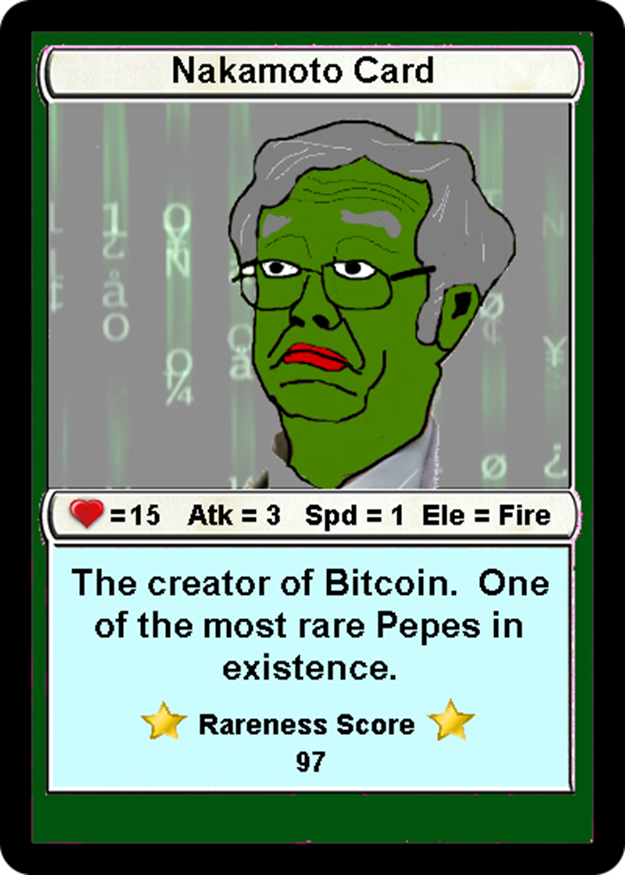
Given that humanity has not yet reached the utopian "post-scarcity" era imagined in science fiction, how should society dictate scarcity? Unlimited energy abundance does not mean we can consume as much as we want, anytime, anywhere, and thus eliminate the need for money. Therefore, we must use that demonic contraption called money to allocate scarce resources. Money, combined with the market, provides society with the best tools for determining what to produce, how much to produce, and who gets to enjoy it. Market prices of goods dictate scarcity. Therefore, the price and quantity of money are the two most important variables in any society. Distortions in either or both variables lead to social dysfunction. Every economic "ism" offers a set of theories that either devalue or glorify the market and all involve some degree of monetary manipulation.
While the free market is a perfect way to arbitrate scarcity, this doesn't mean that more market freedom leads linearly to economic Valhalla. People want to regulate markets and money to curb economic fluctuations. This is the primary purpose of government. Governments provide goods and services that the people believe are best controlled collectively. Alternatively, governments can restrict markets to produce unethical outcomes, such as human slavery. Along with these powers, governments must exert a degree of control over the price and quantity of money. Sometimes governments are benevolent, and sometimes they are despotic monetary dictators. Because governments can legally execute citizens for breaking the law, they can enforce the use of a particular currency. This can lead to both good and bad outcomes.
All governments, regardless of their governing theories, will ultimately devalue their money supply in search of a gateway to a post-scarcity society. Achieving a post-scarcity society won't be achieved through clever money printing, but rather requires a deeper understanding of the physical universe and the ability to manipulate that fabric to our advantage. However, politicians can't wait decades or centuries for a scientific revolution. Therefore, the people's only remedy for a turbulent and uncertain universe is to print more money.
Despite powerful governments, people have always found ways to retain their sovereignty. Many cultures that have experienced centuries of successive governments or dynasties, and endemic inflation, have developed gift-giving rituals to mark important milestones in life—birth, marriage, and death—that involve the exchange of hard currency. In this way, people save through cultural ritual. No politician dares to subvert these rituals, lest they lose their mandate to lead and find themselves beheaded.
In modern times, central governments of all types—democracy, socialist republic, communist state, and so on—have become incredibly powerful thanks to advances in thinking machines and the internet. In such an era, how can we, the people, assert our right to sound money? Satoshi Nakamoto's gift to humanity through his Bitcoin whitepaper is a technological marvel born at a crucial moment in history.
In the current state of human civilization, Bitcoin is the best form of money ever created. Like all currencies, it has relative value. Given that the Pax Americana quasi-empire is governed through the US dollar, we measure the value of Bitcoin in terms of dollars. Assuming the technology functions correctly, the price of Bitcoin will fluctuate based on the price and supply of the US dollar.
The purpose of this philosophical preface is to provide context for my guiding philosophy regarding the duration of Bitcoin/USD price cycles. Bitcoin has already experienced three cycles, with each all-time high (ATH) occurring approximately every four years. As the fourth anniversary of the fourth cycle approaches, traders are looking to apply historical patterns to predict the end of this bull market. They apply this rule without understanding why it worked in the past. Without this historical understanding, they overlook why it will fail this time.
To illustrate why the four-year cycle is dead, I'd like to conduct a simple study of two charts. The primary subject is the price and quantity of money (i.e., the US dollar). Therefore, I will analyze a chart showing the effective federal funds rate and the supply of US dollar credit. The secondary subject is the price and quantity of the Chinese renminbi. For most of human history, China was the wealthiest region on the map, as indicated by the curve. It took a half-century hiatus (1500-2000), but now it's back to compete for the throne of the global economy. The question is, are there any clear turning points at Bitcoin's various all-time highs (ATHs) that roughly explain the price peaks and subsequent crashes? For each four-year cycle, I will provide a summary of monetary trends at the time to explain these charts.
Dollar:
The white line is a measure of the price and supply of U.S. dollar credit. This is a combination of bank reserves held by the Federal Reserve and total other deposits and liabilities of the U.S. banking system. The Fed publishes both data weekly.
The green line represents the effective federal funds rate, which is set by the Federal Open Market Committee (FOMC).
The gold line is the price of Bitcoin/USD.
RMB:
China's economy is more credit-dependent than the U.S., so I used the Bloomberg Economics China Credit Pulse Index 12-month percent change. If you look at the year-over-year percent change in nominal GDP, you get a similar chart.
Back to the past.
Genesis Cycle: 2009 to 2013
On January 3, 2009, Bitcoin generated its first block, the Genesis Block. The 2008 Global Financial Crisis (GFC) ravaged financial institutions worldwide. Banking syndicates, with the connivance of the US government, nearly destroyed the world economy. However, Federal Reserve Chairman Ben Bernanke "saved" the system by implementing unlimited quantitative easing (QE), a policy announced in December 2008 and beginning in March 2009. China, in turn, aided the world economy by increasing credit-fueled infrastructure spending. By 2013, both the Federal Reserve and the People's Bank of China (PBOC) had wavered in their support for unlimited money supply expansion. As you will see, this led to a deceleration in credit growth, or an outright contraction in the money supply, ultimately ending Bitcoin's bull run.
US dollar chart analysis:
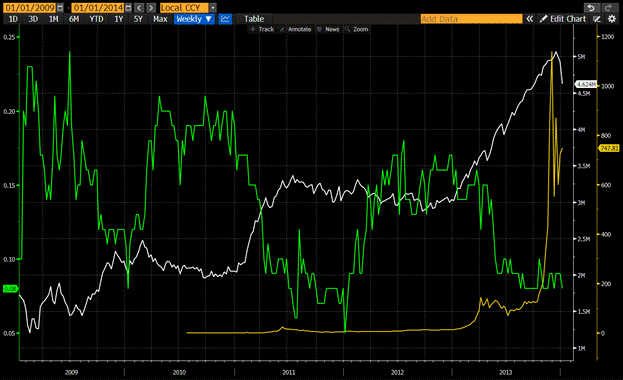
The price of the US dollar is effectively 0%. The supply of US dollars has risen sharply, peaked in late 2013, and is now falling.
RMB chart analysis:

The massive increase in credit growth flooded the world with yuan, with trillions of yuan flowing from China into Bitcoin, gold, and global real estate. By 2013, while credit growth was still substantial, it was nowhere near as rapid as before, and its deceleration coincided with a slowdown in dollar credit growth.
This deceleration in dollar and yuan credit growth has burst the Bitcoin bubble.
ICO Cycle: 2013 to 2017
This was the ICO (Initial Token Offering) cycle, as the Ethereum mainnet launched during this period, pioneering a new issuance model for fundraising using smart contracts on a public blockchain. Bitcoin's rebirth from the ashes was driven by the explosive growth in the supply of RMB, not the US dollar. As shown below, China's credit impulse accelerated in 2015, coinciding with the devaluation of the RMB against the US dollar. Meanwhile, the supply of US dollars declined and interest rates rose. Bitcoin's surge was driven by a massive influx of RMB in global currency markets. Ultimately, as RMB credit growth decelerated from its 2015 peak, tighter US dollar monetary conditions took hold of the bull market, pushing it to its bottom in late 2017.
RMB chart analysis:
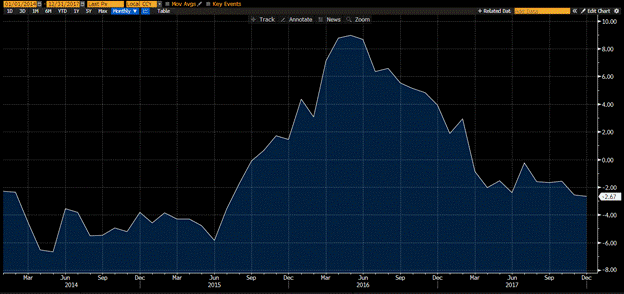
(Describing China's credit pulse accelerating in 2015 and then decelerating)
US dollar chart analysis:
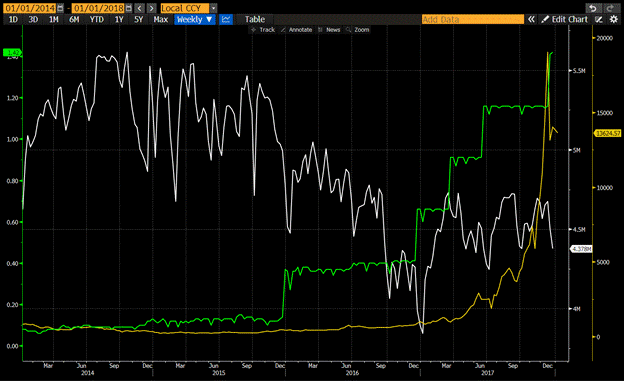
(Describes a decrease in the supply of dollars and an increase in interest rates)
COVID-19 scams: 2017 to 2021
While the coronavirus has indeed killed millions, the crisis was exacerbated by poor government policies. COVID-19 served as a pretext to accustom citizens to a loss of freedom, transcending any particular regional theory of government. In the spirit of "throwing everything against the wall to see what sticks," COVID-19 provided the perfect opportunity for Pax Americana to implement helicopter money. Then-US President Donald Trump delivered the largest populist government handout since Franklin Delano Roosevelt's New Deal. Trillions of dollars were printed and flowed into cryptocurrencies. Trump kept the economy running wild, and all markets rose.
US dollar chart analysis:
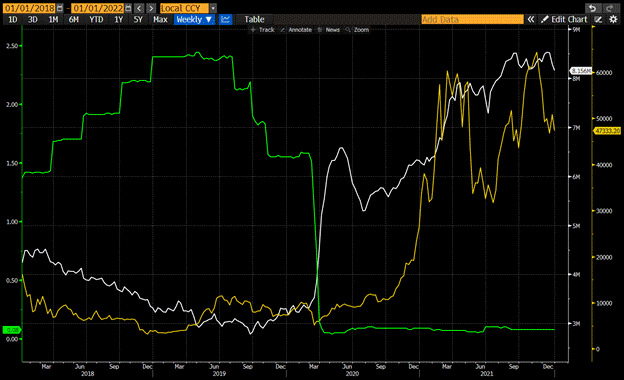
The dollar supply doubled and the price of the currency quickly dropped to 0%.
RMB chart analysis:

While China's credit surged during the pandemic, President Xi Jinping didn't go all-out. He used the pandemic to attack China's real estate bubble. This level of RMB credit growth didn't prevent the plunge in domestic real estate prices triggered by the "three red lines" policy. However, this was intentional; with no one able to enter or leave China at the time, it was easier to control capital outflows and social discontent on the mainland. Therefore, China's monetary policy didn't contribute materially to this Bitcoin bull run.
By the end of 2021, the inflation generated by the "running hot" economic policies of Trump and then US President Biden had become unbearable. Inflation soared, and those without significant financial assets felt shortchanged. The federal government stopped issuing stimulus checks, the Federal Reserve began shrinking its balance sheet, and announced a rapid pace of interest rate hikes. This marked the end of the bull market.
New World Order: 2021 to Present
The quasi-empire of "Pax Americana" is a nostalgic dream. What will happen next? This is the question that global leaders are grappling with. Change itself is neither good nor bad, but it creates economic winners and losers. Sometimes the losers are politically and economically powerful, which creates problems for the ruling party. To protect the public from the negative effects of change, politicians resort to printing money.
This time, the engine of credit growth came from the Federal Reserve's reverse repurchase program (RRP, shown in magenta on the chart, with the y-axis inverted). The price of money rose, and the money supply fell. But Biden needed to stimulate the market. So, his right-hand man, Treasury Secretary "Bad Girl" Yellen, issued more short-term Treasury bills than medium- and long-term Treasury bonds to deplete the RRP. This released approximately $2.5 trillion in liquidity into the market. Her successor, "Buffalo Bill" Bessent, continued this policy until the RRP fell to its current near-zero level. China, on the other hand, has entered a deflationary phase, as evidenced by the negative credit pulse. President Xi remains committed to reducing housing prices and their importance to the Chinese economy. Without further guidance or a change in the outlook for US and Chinese monetary policy, I would agree with many cryptocurrency traders that the bull market is over. But the comments and recent actions of the Federal Reserve and the People's Bank of China suggest otherwise.
US dollar chart analysis:
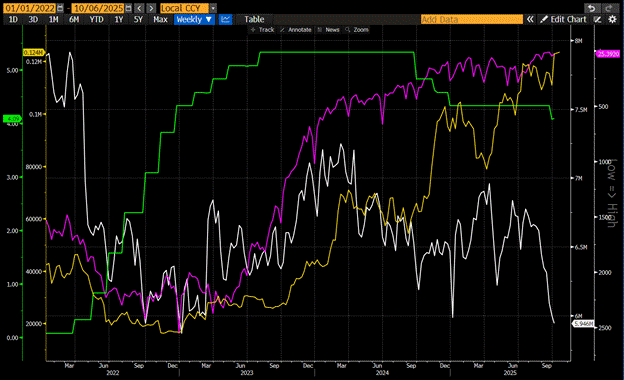
(Describe the process of RRP depletion)
RMB chart analysis:

(Describing China's credit pulse as negative)
In the United States, newly elected President Trump wants to get the economy running hot. He frequently speaks of the need for growth to reduce the nation's debt burden. He criticizes the Federal Reserve for being too tight on the money supply. His desire is translating into action. The Fed resumed interest rate cuts in September, even though inflation remains above its target.
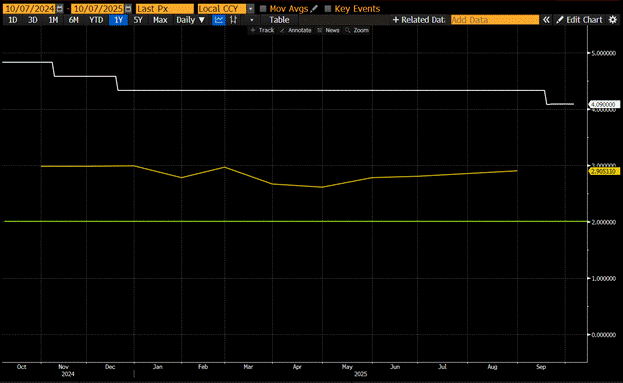
(Chart description: The white line is the effective federal funds rate, the yellow line is core personal consumption expenditures (PCE), and the green horizontal line is the Fed's 2% target.)
Trump has also talked about lowering housing costs to free up trillions of dollars in home equity that was trapped by the rapid rise in home prices after 2008.
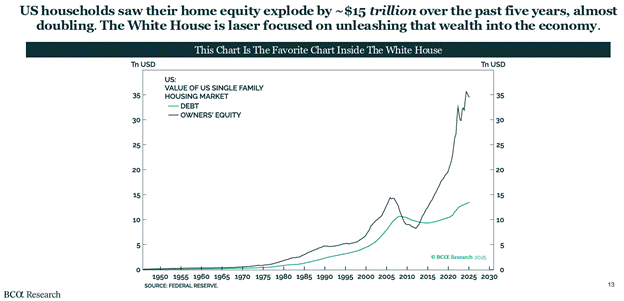
Finally, "Buffalo Bill" Bessant will deregulate banks so that they can increase lending to key industries. The future depicted by the ruling elite points to lower, not higher, interest rates, and higher, not lower, money supply growth.
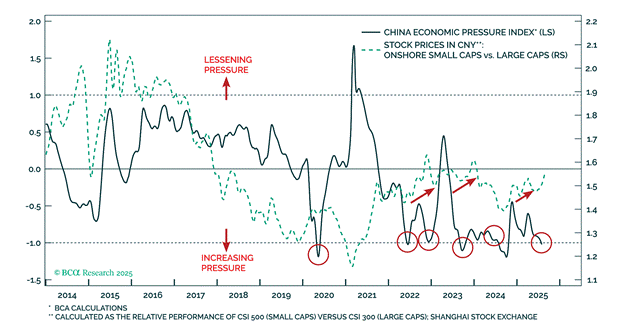
While President Xi doesn't want to issue credit on a massive scale, as he did in 2009 and 2015, he does want to end deflation. When economic pressures become too great, as shown in the BCA chart above, Chinese policymakers will print money. I don't think China will currently be a driver of global fiat credit growth, but it won't hinder it either.
Listen to what our money masters in Washington and Beijing are saying. They're making it clear that money will become cheaper and more plentiful. Therefore, Bitcoin will continue to rise in anticipation of this highly likely future.
The old king is dead, long live the new king!
Link to this article: https://www.hellobtc.com/kp/du/10/6070.html
Source: https://cryptohayes.medium.com/long-live-the-king-f45284bdebd9







